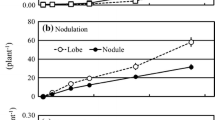Abstract
Nitrogenase activity, hydrogen evolution, biomass production and nodulation were studied in threeCasuarina species,C. equisetifolia Forst.,C. glauca Sieber ex Spreng andC. obesa Miq., either inoculated with a crushed nodule inoculum prepared fromC. glauca nodules or inoculated with the pure cultureHFP CcI3. Nodulation was also studied inC. cristata Miq. inoculated with the above mentionedFrankia sources.
C. equisetifolia, C. glauca andC. obesa were nodulated when inoculated with both of theFrankia inoculum, whileC. cristata was very poorly nodulated. Nitrogenase activity per plant and on a nodule dry weight basis was significantly highest inC. glauca inoculated withC. glauca inoculum after 150 days from planting. This difference decreased and at 217 days from planting there was no significant difference between the symbioses, except forC. obesa inoculated withC. glauca inoculum which showed the significantly lowest nitrogenase activity. After 150 days from planting relative efficiency of nitrogenase was lowest inC. equisetifolia inoculated withHFP CcI3 and inC. equisetifolia inoculated withC. glauca inoculum. Biomass production was similar inC. glauca inoculated withC. glauca inoculum, inC. equisetifolia inoculated withHFP CcI3 and inC. obesa inoculated withHFP CcI3 at the final harvest.
The data presented here show that there is a strong interrelationship between host plant and endobiont. This interrelationship is of considerable importance when introducing Casuarina symbioses for production of fuel wood.
Similar content being viewed by others
References
Aldrich-Blake F N 1932 On the fixation of atmospheric nitrogen by bacteria living symbiotically in root nodules of Casuarina equisetifolia. Oxford For Mem, 14.
Becking J H 1977 Endophyte and association establishment in non-leguminous nitrogen-fixing plants.In Recent Developments in Nitrogen Fixation. Eds. W Newton, J R Postgate. and C Rodriguez-Barrueco pp 551–567. Academic Press, London.
Bond G 1957 The development and significance of the root nodules of Casuarina. Ann. Bot. (Lond) NS 21, 373–380.
Chaney A L and Marbach E P 1962 Modified reagents for determination of urea and ammonia. Clin. Chem. 8, 130–132.
Dixon R O D 1968 Hydrogenase in pea root nodule bacteroids. Arch. Microbiol. 62, 272–283.
Dixon R O D 1972 Hydrogenase in legume root nodule bacteroids: Occurrence and properties. Arch. Microbiol. 85, 193–201.
Huss-Danell K 1978 Nitrogenase activity measurements in intact plants ofAlnus incana. Physiol. Plant. 43, 372–376.
Janse J M 1897 Les endophytes radicaux de quelques plantes Javanaises. Ann. Jard. Bot. Buitenzorg 14, 53–201.
Lawrie A C 1982 Field nodulation in nine species of Casuarina in Victorial. Aust. J. Bot. 30, 447–460.
Miehe H 1918 Anatomische Untersuchung der Pilz-Symbiose beiCasuarina equisetifolia. Flora 111/112, 431–449.
Moore A W 1964 Note on non-leguminous nitrogen fixing plants in Alberta. Can. J. Bot. 42, 952–955.
Mowry H 1933 Symbiotic nitrogen fixation in the genus Casuarina. Soil Sci. 36, 409–426.
Reddell P and Bowen G D 1985 Frankia source affects growth, nodulation and nitrogen fixation inCasuarina species, New Phytol. 100, 115–122.
Reddell P, Bowen G D and Robson A D 1986 Nodulation of Casuarinaceae in relation to host species and soil properties. Aust. J. Bot. 34, 435–444.
Roelofsen W and Akkermans A D L 1979 Uptake and evolution of H2 and reduction of C2H2 by root nodules and nodule homogenates ofAlnus glutinosa. Plant and Soil 52, 571–578.
Schubert K R and Evans H J 1976 Hydrogen evolution: A major factor affecting the efficiency of nitrogen fixation in nodulated symbionts. Proc. Natl. Acad. Sci. USA 73, 1207–1211.
Sellstedt A and Winship, L J 1987 Hydrogen metabolism of Casuarina root nodules: A comparison of two inoculum sources. Physiol. Plant. (in press).
Siegel S 1956 Non-parametric statistics for the behavioral sciences. McGraw-Hill, Kugakusha, Tokyo, 312 p.
Torrey J G 1976 Initiation and development of root nodules of Casuarina (Casuarinaceae). Am. J. Bot. 63, 335–344.
Torrey J G 1982 Casuarina: actinorhizal nitrogen fixing tree of the tropics.In Biological Nitrogen Fixation Technology for Tropical Agriculture. Eds, F H Graham and S C Harris. pp 427–439, CIAT Cali Columbia
Tyson J H and Silver W S 1979 Relationship of ultrastructure to acetylene reduction (N2 fixation) in root nodules of Casuarina. Bot. Gaz. 140 (Suppl). S44-S48.
Zhang Z, Lopez M F and Torrey J G 1984 A comparison of cultural characteristics and infectivity ofFrankia isolates from root nodules ofcasuarina species. Plant and Soil 78, 79–90.
Author information
Authors and Affiliations
Rights and permissions
About this article
Cite this article
Sellstedt, A. Nitrogenase activity, hydrogen evolution and biomass production in different Casuarina symbioses. Plant Soil 105, 33–40 (1988). https://doi.org/10.1007/BF02371140
Received:
Revised:
Issue Date:
DOI: https://doi.org/10.1007/BF02371140




